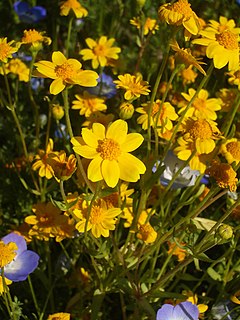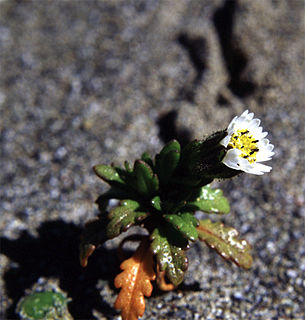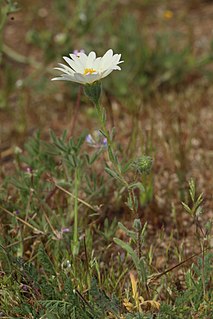
Osteospermum, is a genus of flowering plants belonging to the Calenduleae, one of the smaller tribes of the sunflower/daisy family Asteraceae. They are known as the daisybushes or African daisies.

Layia platyglossa, commonly called coastal tidytips, is an annual wildflower of the family Asteraceae, native to western North America.

Symphyotrichum laeve is a flowering plant native to Canada, the United States, and Coahuila (Mexico). It has the common names of smooth blue aster, smooth aster, smooth-leaved aster, glaucous Michaelmas-daisy and glaucous aster.

Grindelia stricta is a species of flowering plant in the family Asteraceae known by the common names Oregon gumplant, Oregon gumweed and coastal gumplant. It is native to the west coast of North America from California to Alaska, where it is a resident of coastal plant communities such as those in marshes and beaches. This plant is variable in appearance, taking the form of a weedlike perennial herb forming low clumps to a sprawling subshrub growing erect to heights exceeding one meter. Its foliage and stems are green to rusty red or purplish and the plant may be hairy to hairless. The fleshy leaves are green, often with red edges and veining, and are up to 15 centimeters in length on large plants. The inflorescence holds one or more flower heads each up to 5 centimeters wide. The flower head is a cup of thick erect or recurved green phyllaries. Yellow disc florets fill the center of the flower head and there is a fringe of yellow ray florets around the circumference. The head produces copious amounts of white latex, especially in the early stages of blooming.

Lasthenia glabrata is a North American species of flowering plant in the family Asteraceae known by the common names yellowray goldfields and yellow-rayed lasthenia. It is endemic to California, where it is a resident of vernal pools and other moist areas in a number of habitat types. It is widespread across much of the state, from San Diego County to Tehama County.

Layia is a genus of flowering plants in the family Asteraceae known generally as tidy tips, native to western North America. Several are California endemics.

Layia carnosa is a species of flowering plant in the family Asteraceae known by the common name beach tidytips, or beach layia. It is endemic to California, where it lives in beach habitat. It is known from several areas of mostly fragmented coastal habitat, and it was listed as an endangered species in California. On March 31, 2022, the category was changed from endangered species to threatened species by the US Department of the Interior Fish and Wildlife Service.

Layia discoidea is a rare species of flowering plant in the family Asteraceae known by the common name rayless tidytips, or rayless layia.

Layia fremontii is a species of flowering plant in the family Asteraceae known by the common name Frémont's tidytips. Both its common name, and its specific epithet are derived from John C. Frémont.
Layia gaillardioides is a species of flowering plant in the family Asteraceae known by the common name woodland tidytips.

Layia glandulosa is a species of flowering plant in the family Asteraceae known by the common names whitedaisy tidytips and white layia. It is native to western North America south from central Washington (state) to Baja California and east to Utah and Arizona, where it is common in a number of habitat types.

Layia heterotricha is a species of flowering plant in the family Asteraceae known by the common name pale yellow tidytips, or pale yellow layia.
Layia hieracioides is a species of flowering plant in the family Asteraceae known by the common name tall tidytips, or tall layia.
Layia jonesii is a species of flowering plant in the family Asteraceae known by the common name Jones' tidytips, or Jones' layia.
Layia leucopappa is a rare species of flowering plant in the family Asteraceae known by the common name Comanche Point tidytips, or Comanche Point layia.
Layia munzii is a rare species of flowering plant in the family Asteraceae known by the common name Munz's tidytips, or Munz's layia.
Layia pentachaeta is a species of flowering plant in the family Asteraceae known by the common name Sierra tidytips, or Sierra layia.
Layia septentrionalis is an uncommon species of flowering plant in the family Asteraceae known by the common name Colusa tidytips, or Colusa layia.

Bidens laevis is a species of flowering plant in the daisy family known by the common names larger bur-marigold and smooth beggarticks. It is native to South America, Mexico, and the southern and eastern United States. It grows in wetlands, including estuaries and riverbanks.

Calycadenia multiglandulosa is a species of flowering plant in the family Asteraceae, known by the common names sticky calycadenia and sticky western rosinweed. It is endemic to California, where it is a common in the Coast Ranges and in the Sierra Nevada Foothills from Shasta County to Kern County.













